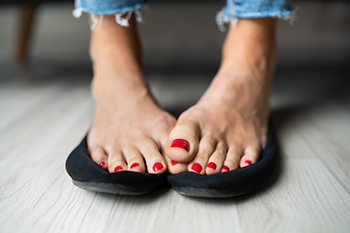Connect With Us
Items filtered by date: March 2023
Recovery Process for a Broken Foot

The long bones in the foot that connect to the toes are known as the metatarsals. They are common bones to fracture, and this may happen from participating in sporting activities or from dropping a heavy object on the foot. Osteoporosis is a medical condition that can cause the bones to become fragile, which may lead to incurring a broken foot. Common symptoms that can accompany this condition can consist of immediate pain, swelling, and bruising. It is often difficult, if not impossible, to walk on it, and crutches may have to be used that can provide mobility. A broken foot is generally diagnosed by having an X-ray taken, and it is followed by wearing a boot or cast, which can provide stability as the healing process occurs. The recovery period is approximately eight weeks before the patient can wear a normal shoe and bear the weight of the body. A full recovery may take longer if the patient is interested in pursuing high impact activities. If you have broken your foot, it is suggested that you consult with a podiatrist who can effectively treat a broken foot.
A broken foot requires immediate medical attention and treatment. If you need your feet checked, contact Ali Davis, DPM from The Foot Clinic. Our doctor can provide the care you need to keep you pain-free and on your feet.
Broken Foot Causes, Symptoms, and Treatment
A broken foot is caused by one of the bones in the foot typically breaking when bended, crushed, or stretched beyond its natural capabilities. Usually the location of the fracture indicates how the break occurred, whether it was through an object, fall, or any other type of injury.
Common Symptoms of Broken Feet:
- Bruising
- Pain
- Redness
- Swelling
- Blue in color
- Numbness
- Cold
- Misshapen
- Cuts
- Deformities
Those that suspect they have a broken foot shoot seek urgent medical attention where a medical professional could diagnose the severity.
Treatment for broken bones varies depending on the cause, severity and location. Some will require the use of splints, casts or crutches while others could even involve surgery to repair the broken bones. Personal care includes the use of ice and keeping the foot stabilized and elevated.
If you have any questions please feel free to contact our office located in Overland Park, KS . We offer the newest diagnostic and treatment technologies for all your foot and ankle needs.
Hiking and Foot Pain

If you are a hiker, you probably relish in the fresh air and exercise hiking gives you. However, as with any other athletic pursuit, hiking can cause injury or discomfort to the feet. If feet are not well-soled, well-rested, or stretched and strengthened for hiking participation, foot problems can easily arise. Foot pain after hiking is typically symptomatic of a foot injury. Repetitive stress on the feet or carrying a heavy backpack while hiking can cause such injuries. Common hiking foot injuries include capsulitis or inflammation of tissues surrounding a joint. This often happens around the ball of the foot and can lead to pain and swelling. This can also affect just one toe, and if left unattended, can lead to hammertoe. Pain might alternatively be centered in the heel area and cause a heel spur and/or plantar fasciitis. If you hike for exercise or pleasure, make sure you wear well-fitted shoes for the activity, stretching and strengthening foot exercises prior to exercising, and rest between hikes. If foot pain persists, it is suggested that you make an appointment with a podiatrist for a diagnosis and treatment plan.
Sports related foot and ankle injuries require proper treatment before players can go back to their regular routines. For more information, contact Ali Davis, DPM of The Foot Clinic. Our doctor can provide the care you need to keep you pain-free and on your feet.
Sports Related Foot and Ankle Injuries
Foot and ankle injuries are a common occurrence when it comes to athletes of any sport. While many athletes dismiss the initial aches and pains, the truth is that ignoring potential foot and ankle injuries can lead to serious problems. As athletes continue to place pressure and strain the area further, a mild injury can turn into something as serious as a rupture and may lead to a permanent disability. There are many factors that contribute to sports related foot and ankle injuries, which include failure to warm up properly, not providing support or wearing bad footwear. Common injuries and conditions athletes face, including:
- Plantar Fasciitis
- Plantar Fasciosis
- Achilles Tendinitis
- Achilles Tendon Rupture
- Ankle Sprains
Sports related injuries are commonly treated using the RICE method. This includes rest, applying ice to the injured area, compression and elevating the ankle. More serious sprains and injuries may require surgery, which could include arthroscopic and reconstructive surgery. Rehabilitation and therapy may also be required in order to get any recovering athlete to become fully functional again. Any unusual aches and pains an athlete sustains must be evaluated by a licensed, reputable medical professional.
If you have any questions please feel free to contact our office located in Overland Park, KS . We offer the newest diagnostic and treatment technologies for all your foot and ankle needs.
Ways to Cope With Sweaty Feet

Having sweaty feet can happen to anyone, especially at the end of the day when your socks have been cooped up in shoes all day. However, some people suffer from a condition called hyperhidrosis of the feet, or sweaty feet. This can be caused by overactive sweat glands, a genetic disorder, and hormonal changes. Because the feet have 250,000 sweat glands, more per inch than any other body part, having hyperhidrosis can turn into an embarrassing problem, namely foot odor. This is the result of bacteria breaking down the sweat and emitting a foul odor. For that reason, following a daily foot hygiene routine is extremely important for anyone with hyperhidrosis. A few tips for coping with sweaty feet include using anti–bacterial soap when washing your feet and applying absorbent foot powder. It is also suggested by experts that you give your shoes a chance to air out and alternate pairs daily. Switching to socks that absorb moisture and using medicated insoles in your shoes are other common coping methods. If none of these measures help, it may be time to consult a podiatrist who can offer more advanced treatment solutions, such as Botox injections and low-power electric current therapy.
If you are suffering from hyperhidrosis contact Ali Davis, DPM of The Foot Clinic. Our doctor can provide the care you need to attend to all of your foot and ankle needs.
Hyperhidrosis of the Feet
Hyperhidrosis is a rare disorder that can cause people to have excessive sweating of their feet. This can usually occur all on its own without rigorous activity involved. People who suffer from hyperhidrosis may also experience sweaty palms.
Although it is said that sweating is a healthy process meant to cool down the body temperature and to maintain a proper internal temperature, hyperhidrosis may prove to be a huge hindrance on a person’s everyday life.
Plantar hyperhidrosis is considered to be the main form of hyperhidrosis. Secondary hyperhidrosis can refer to sweating that occurs in areas other than the feet or hands and armpits. Often this may be a sign of it being related to another medical condition such as menopause, hyperthyroidism and even Parkinson’s disease.
In order to alleviate this condition, it is important to see your doctor so that they may prescribe the necessary medications so that you can begin to live a normal life again. If this is left untreated, it is said that it will persist throughout an individual’s life.
A last resort approach would be surgery, but it is best to speak with your doctor to find out what may be the best treatment for you.
If you have any questions please feel free to contact our office located in Overland Park, KS . We offer the newest diagnostic and treatment technologies for all your foot and ankle needs.
Leading Cause of Morton’s Neuroma

Morton’s neuroma is a condition that involves the feet. The medical name for this is known as Morton’s metatarsalgia or interdigital neuroma, and it affects the nerve between the third and fourth toes. Wearing high heels that do not have adequate room in the toe area is the leading cause of Morton’s neuroma. Wearing these types of shoes may cause this nerve to become compressed and is often painful and uncomfortable. Additionally, it may happen to patients who frequently participate in running and jumping activities, or to people who have flat feet or high arches. Common symptoms that are associated with this condition can include a tingling sensation that may eventually become a sharp and shooting pain. Numbness can accompany this ailment, and relief may be found when looser shoes are worn. If you have this type of pain, it is suggested that you contact a podiatrist who can provide treatment options, which may include wearing custom-made orthotics.
Morton’s neuroma is a very uncomfortable condition to live with. If you think you have Morton’s neuroma, contact Ali Davis, DPM of The Foot Clinic. Our doctor will attend to all of your foot care needs and answer any of your related questions.
Morton’s Neuroma
Morton's neuroma is a painful foot condition that commonly affects the areas between the second and third or third and fourth toe, although other areas of the foot are also susceptible. Morton’s neuroma is caused by an inflamed nerve in the foot that is being squeezed and aggravated by surrounding bones.
What Increases the Chances of Having Morton’s Neuroma?
- Ill-fitting high heels or shoes that add pressure to the toe or foot
- Jogging, running or any sport that involves constant impact to the foot
- Flat feet, bunions, and any other foot deformities
Morton’s neuroma is a very treatable condition. Orthotics and shoe inserts can often be used to alleviate the pain on the forefront of the feet. In more severe cases, corticosteroids can also be prescribed. In order to figure out the best treatment for your neuroma, it’s recommended to seek the care of a podiatrist who can diagnose your condition and provide different treatment options.
If you have any questions, please feel free to contact our office located in Overland Park, KS . We offer the newest diagnostic and treatment technologies for all your foot care needs.
Reminder: When Was the Last Time...?
Blog Archives
- April 2025
- March 2025
- February 2025
- January 2025
- December 2024
- November 2024
- October 2024
- September 2024
- August 2024
- July 2024
- June 2024
- May 2024
- April 2024
- March 2024
- February 2024
- January 2024
- December 2023
- November 2023
- October 2023
- September 2023
- August 2023
- July 2023
- June 2023
- May 2023
- April 2023
- March 2023
- February 2023
- January 2023
- December 2022
- November 2022
- October 2022
- September 2022
- August 2022
- July 2022
- June 2022
- May 2022
- April 2022
- March 2022
- February 2022
- January 2022
- December 2021
- November 2021
- October 2021
- September 2021
- August 2021
- July 2021
- June 2021
- May 2021
- April 2021
- March 2021
- February 2021
- January 2021
- December 2020
- November 2020
- October 2020
- September 2020
- August 2020
- July 2020
- June 2020
- May 2020
- April 2020
- March 2020
- February 2020
- January 2020
- December 2019
- November 2019
- October 2019
- September 2019

